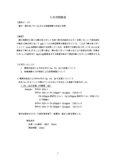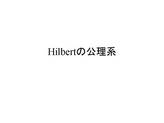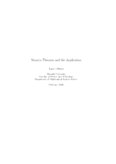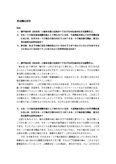代表キーワード :: 理工学
資料:680件
-
 Rotating Angles
Rotating Angles
- A rectangle OABC rotates counter clockwise about the point O as shown in the diagram below, which is not drawn to scale Initially O is at (0,0), A is at (4,0), B is at (4,3), C is at (0,4). The diagram shows the rectangle after it has rotated through 20 ...
 1,320 販売中 2005/07/30
1,320 販売中 2005/07/30- 閲覧(1,137)
-
 親水・疎水性パタン化された有機薄膜の作成と利用(5月月報)
親水・疎水性パタン化された有機薄膜の作成と利用(5月月報)
- 【今月行ったこと】 1. 標準添加法による中水中のCa、Fe、Brの定量について 2. 有機薄膜のUV照射による改質時間について
 550 販売中 2005/12/22
550 販売中 2005/12/22- 閲覧(1,129) コメント(4)
-
 THE TOPOLOGY FILMS PROJECT
THE TOPOLOGY FILMS PROJECT
- This film is about the forming curve in the plane. You can think the curve with the pass with the moving point. But we will acquit the curve satisfied certain condition. First, we only consider closed curves. That is closed with the moving point return to th...
 550 販売中 2006/01/20
550 販売中 2006/01/20- 閲覧(1,125)
-
 Heats of Reaction
Heats of Reaction
- *Aim According to Hess’s law, the heat of reaction of the one reaction should be equal to the sum of the heats of reaction for the other two. Measure the heat released by 3 reactions by using a Styrofoam-cup to than calculate for the heat of reaction, ΔH, fo...
 550 販売中 2005/07/21
550 販売中 2005/07/21- 閲覧(1,123)
-
 Neutralization, Combustion and Heat of Reaction
Neutralization, Combustion and Heat of Reaction
- Aim: /Experiment 1. Find out the ΔH of neutralization /Experiment 2. Find out the heat of combustion of the ethanol. /Experiment 3. Find out the heat of reaction between CuSO4 and Mg. Hypothesis: /Experiment 1. I think the result become negati...
 550 販売中 2005/07/21
550 販売中 2005/07/21- 閲覧(1,116)
-
 HILBERTの公理系
HILBERTの公理系
- 交点の存在、対角線の交差、equalの意味・・・
 550 販売中 2006/02/07
550 販売中 2006/02/07- 閲覧(1,108)
-
 Sturm`s Theorem and the Application
Sturm`s Theorem and the Application
- Chapter 1 Sturm’s Theorem 1.1 Sturm’s Thorem Definition 1.1 We define that the number of changed sign V (a1, · · · , an) for a = 1, · · · , an ∈ R is as follows. For the sequense (a1, · · ·...
 3,300 販売中 2006/02/08
3,300 販売中 2006/02/08- 閲覧(1,107)
-
 Wavelength Lab
Wavelength Lab
- In this experiment, I don’t think there is not so much error. The reason for this is because we can only make an error in the measurement. The room temperature, humidity may cause some changes but I think in this experiment, we don’t have much effect by thes...
 550 販売中 2005/07/30
550 販売中 2005/07/30- 閲覧(1,106)
-
 What is DSL?
What is DSL?
- What is DSL? I researched about DSL. DSL is a very high-speed connection for Internet. There are several kinds of popular connections for Internet. One ways is modem, which we use telephone line. Second way is LAN (Local Area Network). This connection mos...
 550 販売中 2006/01/05
550 販売中 2006/01/05- 閲覧(1,096)
-
 Observing Oxidation and Reduction Reactions
Observing Oxidation and Reduction Reactions
- *Station1; test tube, copper (II) sulfate, small piece of zinc *Station2; test tube, iron (III) chloride, small piece of zinc, 5 drops of potassium hexacyanoferrate *Station3; test tube, 1.0M hydrochloric acid, small strip of magnesium metal, wooden splint,...
 550 販売中 2005/07/30
550 販売中 2005/07/30- 閲覧(1,094)
-
 Investin Sequence
Investin Sequence
- From the question above, we can see that for n = 1, we will get 1 x 1! by the equation. And for n = 2, we have 2 x 2! and identically, we have 3 x 3!, when n = 3. There is a simple pattern. So, we can understand that the n x n! is the formula for the nth ter...
 1,320 販売中 2005/07/30
1,320 販売中 2005/07/30- 閲覧(1,091)















